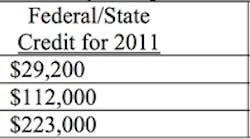Sometimes the Internal Revenue Code giveth more than it taketh. Section No. 41 of the Code — creates the Research and Development tax credit, “R & D Credit” for short — is designed to be your tax pal. But he’s a complicated fella.
Here’s why No. 41 is such a good tax friend: He allows you to get two tax advantages, a deduction and a credit, for a single expenditure. For example, say you spend $1,000 for wages on a qualified R & D project. First, you get a $1,000 deduction. Second, you use the same $1,000 to make a calculation that gives you a credit, which can be deducted dollar-for-dollar to reduce your income tax liability. Cool!
The R & D credit has been around since 1981. Many states have joined the tax-saving fun, awarding you a credit on your state tax bill. The credit is available to every type of entity: for example, an S or C corporation, LLC, partnership, etc.
In a nutshell, the R & D credit applies to any company that makes, improves or develops products, software and/or processes. As you can see, every day stuff … not just scientists or engineers in a lab.
When you consider getting into the R & D credit game, you must assess these two factors: do “qualifying activities/projects” take place and what amount of “qualifying expenses” do you incur?
Qualifying activities/projects
Your company is in if you do any of the following: develop/improve/test new concepts and/or technology; certification testing; manufacture products; create new, improved or more reliable products, formulas or processes; create prototypes or models, including computer generated models; automate, streamline or improve internal processes; develop or improve production, manufacturing process, software or hardware; add or improve equipment; try using new materials; design new or improved tools, dies, molds or other devices. Or you hire outside consultants or contractors to do any of the above. If you have an R & D product development or design department or provide engineering, design or testing services for your customers, qualifying activities are likely taking place.
Qualifying expenses
Once qualifying activities/projects have been identified, you must accumulate certain expenses (qualifying expenses) to determine your R & D credit. Internal labor (i.e., salaries, wages, bonuses), costs of supplies consumed and third-party consultant/contractor expenses are the prime qualifying expenses.
These expenses normally take place in many areas of your business, not just in your R & D or engineering departments.
Documentation
And, of course, you must properly document. Retaining such items as: product and/or project specification, descriptions or proposals; technical reports/test reports and results; patent applications and results; contractual agreements with consultants; and other documents that support your qualifying activities and expenses with an organized system are essential in case of an IRS audit.
Maximizing R & D credit
Naturally, you want to maximize your R & D credit opportunity. The fact is you’ll need professional help. Think of building a new plant or warehouse. You would not even think of doing it without hiring an experienced architect and general contractor.
The rewards of your Credit are easy to explain. For example, a few real-life cases:
All of the above examples are real clients of Scott Schmidt, principal of the Black Line Group. Scott, a member of my network of professionals, is the recognized guru of the R & D credit area in the U.S. Scott provided most of the information for this article.
It should be noted that if you have been doing your R & D credit planning internally, you are probably leaving money on the table. Think your company can take advantage of the R & D Credit? Or have a question. Contact Scott directly via phone at 763-550-0111 or e-mail: [email protected].
Irv Blackman, CPA and lawyer, is a retired partner of Blackman Kallick LLP and chairman emeritus of the New Century Bank, both in Chicago. He can be reached at 847-674-5295, e-mail [email protected], or on the Web at: www.taxsecretsofthewealthy.com.



